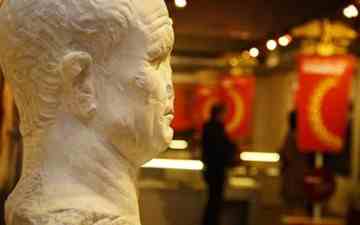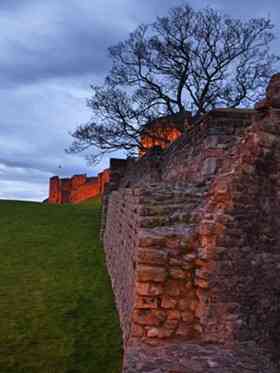It’s big, it’s bold, it’s the best-known frontier in the world (the Roman world, that is) – and it’s here in England. Although built almost 2,000 years ago, Hadrian’s Wall – spanning England’s northern countryside from Wallsend in the east to Bowness-on-Solway in the west – still evokes the excitement of teetering on the edge of unknown territory.
 Began in AD 122 by Emperor Hadrian as the north-west frontier of the Roman Empire, the 73-mile wall, with numerous turrets and milecastles, is a now a World Heritage Site. But a visit to Hadrian’s Wall Country is about far more than looking at a pile of stones (albeit the finest Roman monument in Britain).
Began in AD 122 by Emperor Hadrian as the north-west frontier of the Roman Empire, the 73-mile wall, with numerous turrets and milecastles, is a now a World Heritage Site. But a visit to Hadrian’s Wall Country is about far more than looking at a pile of stones (albeit the finest Roman monument in Britain).
Here, you can discover the first flushing loo (yes, really) and what Romans ate for breakfast; you can be whisked back in time to explore the streets of a Roman settlement or dig for Roman pottery; you can spot oystercatchers and curlews, dip a toe in the sea, or picnic while gazing into Scotland – one very good reason, of course, why the Wall was built here.
Frontier experience
Stand on Sewingshields Crags, close to Housesteads Fort, for a tingling, tangible sense of what this Wall is all about. Snaking away to the west in magnificent switchbacks, it’s a formidable defence: no one could possibly sneak up unseen. A little further west, Cawfields Crags is another good vantage point with a well-preserved milecastle (a fortlet that could hold up to 30 men) and good views south to the Vallum, a flat-bottomed, steep-sided ditch flanking the Wall and all part of Hadrian’s clever defence.
The Wall itself would have been bigger in Hadrian’s day – up to around 20ft high and 10ft wide – but time and the odd plundering house-builder have pared it down. Visit Vindolanda or Segedunum to see a full-scale replica.
Clever folk, those Romans
You might imagine the flushing loo was a relatively recent invention; take a trip to Housesteads Fort, near the centre of the Wall, and think again. The loos were built at the lower side of the fort so that water could drain through them and carry everything away naturally by gravity. Neat, eh? Housesteads also has the precursor to modern central heating: underfloor pipes carrying hot air, known as hypocausts.
 Luckily for us, Housesteads is fantastically preserved: it’s the most complete Roman fort in Britain, with clearly identifiable ruins of barrack rooms, granaries, gateways, the commanding officer’s house and even a hospital.
Luckily for us, Housesteads is fantastically preserved: it’s the most complete Roman fort in Britain, with clearly identifiable ruins of barrack rooms, granaries, gateways, the commanding officer’s house and even a hospital.
Outside the fort’s walls, you can still see the terracing in the hillside that the Romans developed as a way of turning the steeply rising ground into usable farming land to feed the 800 men stationed here. The on-site museum has an excellent model of how it would have looked in Hadrian’s day.
Visit Chesters cavalry fort and lounge around in the best-preserved Roman bathhouse in the country, complete with hot, cold and steam rooms; at nearby Roman Corbridge, stroll the high street of this prosperous garrison town, with its remains of granaries, markets, workshops and aqueduct-fed fountain.
A day in the life
“I have sent you… socks… two pairs of sandals and two pairs of underpants.” This letter (ink on slivers of wood), probably from mother to son, is part of a stack of written material excavated at Roman Vindolanda. It’s the earliest example of correspondence in British history and from next spring will be one of a selection of Vindolanda writing tablets which will once again be displayed in a revamped museum.
Together with its superb remains, including barracks, bathhouse, high street and full-scale replicas of a temple and shop, Vindolanda gives a real insight into Roman and early British life. At Arbeia, the fort guarding the River Tyne at South Shields, you can compare the differing levels of comfort between a commanding officer’s, centurion’s and soldier’s living quarters in the authentic reconstructions, and also try your hand at being an archaeologist.
Head to the coast
The Wall, in the west, technically ends at Bowness-on-Solway but the Romans took no chances (the Irish Sea was an open invitation to unwelcome visitors) and built defences down the coast. Discover (yet another) bathhouse at Ravenglass Roman Bath House (at 13ft, the remains are impressively high), while Senhouse Fort and Museum are perched dramatically on the cliffs at Maryport (with exciting museum expansion plans for 2013).
This area of Hadrian’s Wall Country can surprise. Did you know the World Owl Centre is here, at Muncaster Castle, near Ravenglass? Arrive for the daily display and meet some of the 40 species, from tiny pygmy owls to giant eagle owls. Or how about the fact that the dunes and salt marshes here contain rare natterjack toads and wild pansies?
The area is also one of the quietest parts of the Lake District National Park; there’s superb walking up Eskdale, with (don’t you know it?) another Roman fort at Hardknott Pass. A fun way to explore is to combine a trip on the dinky Ravenglass and Eskdale narrow-gauge steam railway with scene-stealing walks.
Frontier city
Nine miles from Scotland and one mile south of the Wall, Carlisle is a true frontier city. Fought over by Romans, English, Scottish and greedy Border reivers, it’s learnt to be tough, yet it is on an appealing human scale.
 Dominating the skyline, the Norman castle has everything a fortress should have: moat, portcullis, dank dungeons, battlements and mighty-walled keep. At Tullie House Museum and Art Gallery, choose your period – Roman, medieval, Victorian – to find fascinating objects that reveal the lives of ordinary folk, be it a Roman arrow-firer or a 19th-century whisky smuggler’s pannier.
Dominating the skyline, the Norman castle has everything a fortress should have: moat, portcullis, dank dungeons, battlements and mighty-walled keep. At Tullie House Museum and Art Gallery, choose your period – Roman, medieval, Victorian – to find fascinating objects that reveal the lives of ordinary folk, be it a Roman arrow-firer or a 19th-century whisky smuggler’s pannier.
There’s gorgeous Pre-Raphaelite art, a Jacobean garden and, next year, the Roman Frontier Gallery reopens, promising exciting interactive displays. Carlisle’s 12th-century cathedral offers a quiet retreat with its medieval glass, carved-oak misericords and star-spangled choir ceiling.
And, if you’re missing your Hadrian fix, nearby Birdoswald Fort makes a great day out.
Escape…
Frontier country, by definition, is wild, remote and unspoilt, and Hadrian’s Wall Country doesn’t disappoint. In the west, the Solway Firth’s salt marshes and mudflats, an Area of Outstanding Natural Beauty, offer a haunting loveliness that teems with birdlife, such as oystercatchers, barnacle geese and curlews.
Time it right and you might spot ospreys around Greenlee Lough near Bardon Mill, a nature reserve in the Northumberland National Park.
There are quiet lanes for horse-riding or ruins such as Lanercost Priory to explore. You can walk (or cycle) the length of the Wall (both have designated routes) but there are dozens of shorter walks.
For example, stroll the banks of the Tyne from Wylam to Prudhoe, taking in Prudhoe’s Norman Castle and George “the Rocket” Stephenson’s cottage. More strenuous is a walk around Crag Lough, along Highshield Crags, swooping down Sycamore Gap (made famous by Kevin Costner in Robin Hood Prince of Thieves) and ending on Peel Crags with glorious views.
For a perfect picnic spot, head to Walltown Crags, near Haltwhistle. From here, you can see west into Cumbria and south to the Pennines.
Author: Helen Pickles | Source: Telegraph [September 24, 2010]